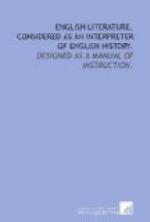TEUTONIC CLASS. | .--------------------+-------------------. | | | High German branch. Low German branch. Scandinavian branch. | Dead | Languages. .----------+--------------+-------------+------------. | | | | | Gothic. Old Dutch. Anglo-Saxon. Old Frisian. Old Saxon. | English.
Without attempting an analysis of English to find the exact proportion of Saxon words, it must be observed that Saxon is the root-language of English; it might with propriety be called the oldest English; it has been manipulated, modified, and developed in its contact with other languages—remaining, however, radically the same—to become our present spoken language.
At this period of our inquiry, we have to do with the Saxon itself, premising, however, that it has many elements from the Dutch, and that its Scandinavian relations are found in many Danish words. The progress and modifications of the language in that formative process which made it the English, will be mentioned as we proceed in our inquiries.
In speaking of the Anglo-Saxon literature, we include a consideration also of those works written in Latin which are products of the times, and bear a part in the progress of the people and their literature. They are exponents of the Saxon mind, frequently of more value than the vernacular writings.
EARLIEST SAXON POEM.—The earliest literary monument in the Saxon language is the poem called Beowulf, the author and antiquity of which are alike unknown. It is at once a romantic legend and an instructive portraiture of the earliest Saxon period—“an Anglo-Saxon poetical romance,” says Sharon Turner, “true in costume and manners, but with an invented story.” Before proceeding to a consideration of this poem, let us look for a moment at some of the characteristics of Saxon poetry. As to its subject-matter, it is not much of a love-song, that sentiment not being one of its chief inspirations. The Saxon imagination was inflamed chiefly by the religious and the heroic in war. As to its handling, it abounded in metaphor and periphrasis, suggestive images, and parables instead of direct narrative.
METRICAL ARRANGEMENT.—As to metrical arrangement, Saxon poetry differed from our modern English as well as from the classical models, in that their poets followed no laws of metre, but arranged their vernacular verses without any distinct rules, but simply to please the ear. “To such a selection and arrangement of words as produced this effect, they added the habit of frequently omitting the usual particles, and of conveying their meaning in short and contracted phrases. The only artifices they used were those of inversion and transition."[7] It is difficult to give examples to those unacquainted with the language, but the following extract may serve to indicate our meaning: it is taken from Beowulf:




